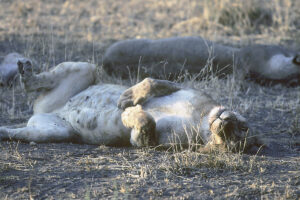Kaj Halberg - writer & photographer
Travels ‐ Landscapes ‐ Wildlife ‐ People
Tanzania 1990: Lions in the camp
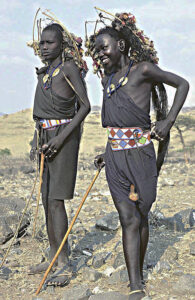
Torbjørn Eriksen, Frederik Brammer, John Faldborg, and I have been sent to Tanzania by the Danish section of the International Council for Bird Preservation (ICBP) to count birds, and to ring as many as possible, in various Tanzanian coastal forests.
[Later, the International Council for Bird Preservation changed its name to Birdlife International.]
After working in the forests for seven weeks, we would now like to make a round-trip to some of the country’s famous national parks: Serengeti, Ngorongoro, Lake Manyara, and Tarangire.
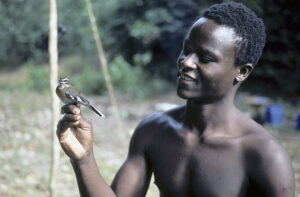

The land here is a harsh and inhospitable semi-desert with scattered vegetation of grasses and trees. Nevertheless, there are people living here. No matter where we make a stop, a couple of Masai warriors, or morani, will appear, armed with long spears as a means of defense against lions, or a herdsman will pass with his herd of cattle, heading for a small patch of greenery along one of the few watercourses in this region.
Lake Natron is a huge, shining expanse, dotted with rocky outcrops, which shimmer in the intense heat, assuming unreal shapes. Spread out across the lake, large flocks of lesser flamingos (Phoeniconaias minor) are feeding.
The lake shore is a crust of hardened mud, mixed with soda, and along the shore are huge salt marshes, in which lots of waders are feeding, along with pink-backed pelicans (Pelecanus rufescens), glossy ibises (Plegadis falcinellus), yellow-billed storks (Mycteria ibis), African spoonbills (Platalea alba), and other birds.
In grassy areas, we observe plains zebras (Equus quagga ssp. boehmi), white-bearded wildebeest (Connochaetes taurinus ssp. mearnsi), and Thomson’s gazelles (Eudorcas nasalis).
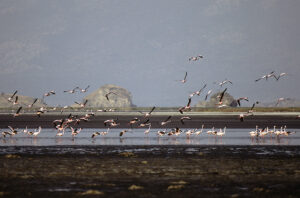
Among rocky outcrops, we find a few beautiful desert roses (Adenium obesum) in bloom – the only flowering plant we observe around here. This species was described in 1763 by Swedish scientist Pehr Forsskål, who participated in a Danish expedition to Egypt and the Yemen 1761-1767. Flowers of this plant resemble those of the oleander (Nerium oleander), but its trunk is very fat, causing Forsskål to name it Nerium obesum (‘the obese oleander’).
Forsskål’s fascinating, albeit short, life is related on the page People: Pehr Forsskål – brilliant Swedish scientist.

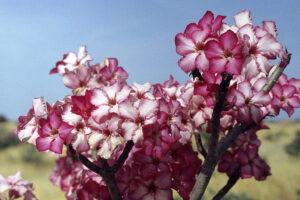
Driving is not allowed in the national park after dark, but nevertheless our driver, Nuru, is of the opinion that we should head for the camp site near Lobo Lodge. When we arrive at the lodge, a staff member directs us to his quarters, where his boss informs Nuru that he has violated the regulations of the park and must pay a fine of 2000 Shillingi.
When we have pitched our tents, Nuru drives to the staff quarters to pay his fine. As it turns out, the chief ranger is now very drunk. He calls the whole affair a trifle, informing Nuru that he doesn’t have to pay any fine. The following morning, however, when we are about to leave Lobo, he has once again changed his mind, and Nuru must pay the fine!
Lobo is a beautiful place. The lodge has been built among a group of kopjes – isolated rocky outcrops, which, somewhat wantonly, pierce the savanna here and there. Incidentally, they are the remains of ancient, eroded mountains. To the Boer, when they migrated to Southern Africa in the 1700s, these outcrops resembled heads, so they named them kopjes (‘head’ in Dutch).
Two striking black-and-white Verreaux’s eagles (Aquila verreauxii) are soaring above a kopje, on which two Masai klipspringers (Oreotragus oreotragus ssp. schillingsi) rest, enjoying the morning sun. The outer keratin layer on the hooves of these small antelope is rubber-like, causing them to have a tremendously firm grip on the surface of the steep rocks.

We observe many other animals, including a small antelope, the steenbok (Raphicerus campestris), and the rather rare side-striped jackal (Canis adustus).
Nuru makes a brief stop to talk to an acquaintance, and he learns that a large male leopard (Panthera pardus) is busy eating a cheetah (Acinonyx jubatus) in a tree near Seronera!
Naturally, we race to the spot, but on our arrival, the leopard is slumbering peacefully, sprawled on a thick branch in an acacia tree. The remains of the cheetah are draped over a nearby branch.
We stay in the area, hoping that the leopard will soon wake up to continue his meal, but he just sleeps and sleeps. For many hours we wait patiently, and finally, when the sun is low, the leopard wakes up, stretching and yawning, baring his formidable canines. He then returns to his prey and proceeds to eat, illuminated by the setting sun, while in the east, behind the tree, a Full Moon is rising. A spectacular event indeed!
The leopard is described in detail on the page Animals – Mammals: The spotted killer.
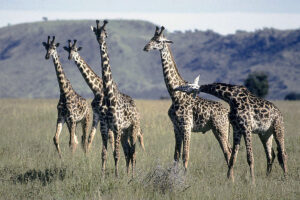
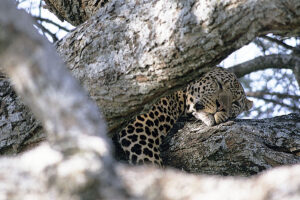
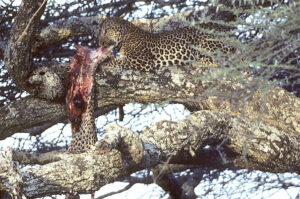
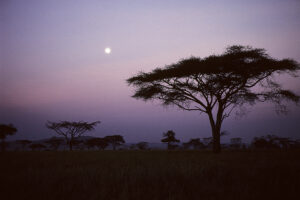
One hot night, Torbjørn opens his tent to let in some cool air. Later in the night, he spots a spotted hyena (Crocuta crocuta), peeping into his tent. He manages to scare it away, but during the rest of our trip, he does not open his tent at night anymore, heat or no heat!
Driving south towards Naabi Hill, we observe lots of larks along the road, mostly red-capped larks (Calandrella cinerea) and Fischer’s sparrow-larks (Eremopterix leucopareia). Masai ostriches (Struthio camelus ssp. massaicus) and kori bustards (Otis kori) are also fairly common. We observe a South African wildcat (Felis libyca ssp. cafra), rolling in sand, oblivious of our presence. It is mobbed by numerous rosy-breasted longclaws (Macronyx ameliae).
Every evening, our camp at Naabi is paid a visit by a striped hyena (Hyaena hyaena), but we fail to find its den.
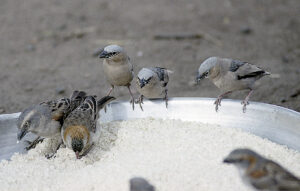
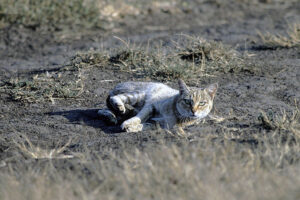
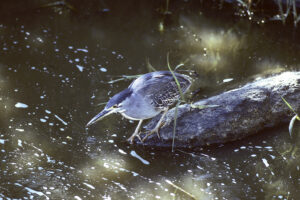
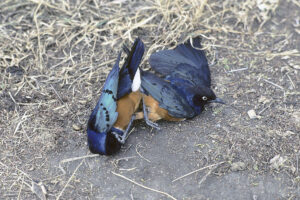
On the crater floor, a mixed herd of white-bearded wildebeest and plains zebras is crossing the large soda lake, and a couple of black rhinos (Diceros bicornis) nearby are so massive that they resemble tanks. Two zebra stallions are engaged in a fierce battle. They bite and kick each other, trying their best to topple their opponent and bite his testicles.
During the following days, we encounter several courting lions (Panthera leo). Lion pairs are diligent lovers, mating as many as fifty times in a 24-hour period. A lioness is sprawled on a branch about 5 metres up in a tree, probably to escape biting flies.
When we encounter a large complex of spotted hyena dens, we spend several hours here to observe their social life. Two pups are engaged in playing. A half-grown, pale-grey one is busy gnawing on a bone, but is ‘attacked’ by a much smaller, black pup, which bites its ears, trying its best to steal the bone.
Birdlife in the crater lakes is very rich indeed. Lesser flamingo is numerous, and we also observe maccoa duck (Oxyura maccoa), Cape teal (Anas capensis), avocet (Recurvirostra avosetta), chestnut-banded plover (Charadrius pallidus), and Kittlitz’ plover (C. pecuarius), the latter with tiny chicks.
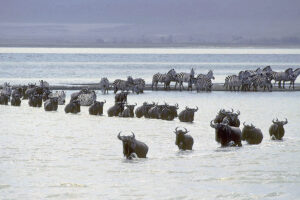

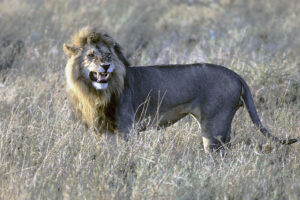
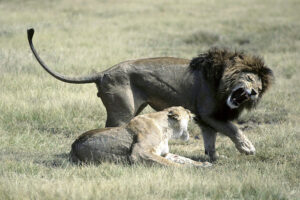

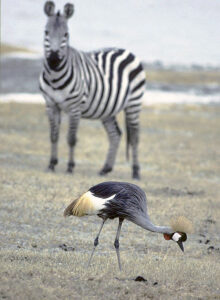
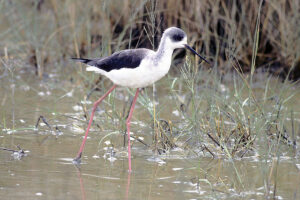
Large herds of animals come to drink from the streams, including elephants (Loxodonta africana), impalas, and African buffalos (Syncerus caffer). For a long time, a herd of buffaloes seem petrified, trying to catch our scent. Suddenly they turn around, disappearing in a dense cloud of dust. Near the river, a female leopard has dragged an impala up into an acacia, in which its half-grown cub is lying, gorging itself on the carcass.
We spend some time observing the daily life of a pack of dwarf mongoose (Helogale parvula). These small carnivores live in family groups, comprising up to twenty individuals, dominated by a matriarch, who will only mate with the strongest male in the group. The pack often lives in a termite mound, and the males act as guardians on top of the mound to warn the group against enemies like eagles, snakes, and jackals. For this reason, more males than females are killed by these enemies.
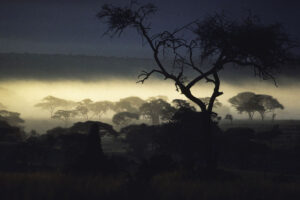
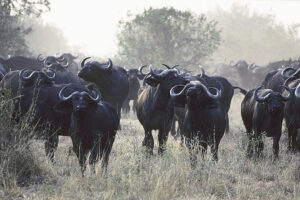
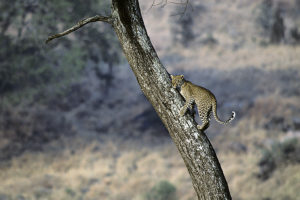
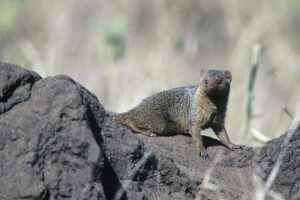
One night, our camp is paid a visit by a pride of lions. One is roaring just outside John’s tent, while others lie down close to my tent. I hear a strange noise, like ’toc-toc-toc’ – it must be a lion’s tail, knocking on the canvas!
I’m scared stiff, lying absolutely still, waiting for them to disappear. The strain on my nerves makes me so tired that, against all odds, I fall asleep.
The following morning, we discuss the events of the night.
”The lion was roaring so close to my tent that the canvas was flapping!” says John.
”Yes,” says Torbjørn. ”They were indeed very close!”
I also give an account of my adventure with the lion’s tail.
Frederik, however, hasn’t got a clue what we are talking about. His only comment is: ”There were lions in the camp?”
The lion is described in detail on the page Animals – Mammals: Lion – king of the savanna.
